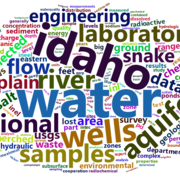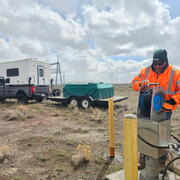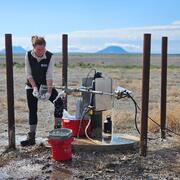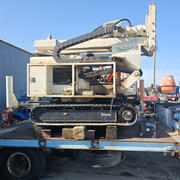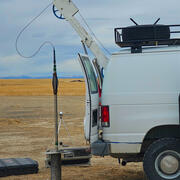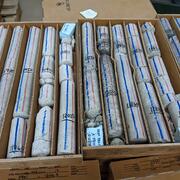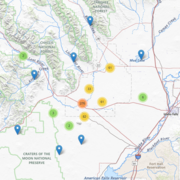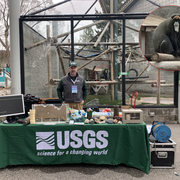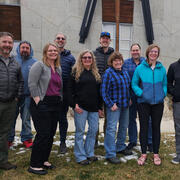Idaho National Laboratory Project Office
Idaho National Laboratory Project Office
Filter Total Items: 12
INLPO Software
Our science staff has developed a suite of software products designed to enhance research and data analysis capabilities. Each product plays a crucial role in facilitating access to data and analyses relevant to groundwater and surface water monitoring in the region.
INLPO Publications
Since the establishment of the U.S. Geological Survey (USGS) project office at the Idaho National Laboratory (INL) in 1949, we have produced a wealth of significant scientific publications that contribute to our understanding of groundwater monitoring and research. Our findings provide critical insights into the impacts of waste disposal on the eastern Snake River Plain aquifer and the long-term...
INLPO Water Monitoring
The U.S. Geological Survey (USGS) first characterized the water resources of the Idaho National Laboratory (INL) area prior to the establishment of nuclear reactor testing facilities in 1949. Since then, the USGS has maintained monitoring networks for groundwater quality and water levels at the INL. These efforts provide essential data on hydrologic trends and track the movement of radioactive and...
INLPO Groundwater Flow Modeling
At the Idaho National Laboratory Project Office (INLPO), we employ advanced numerical models to enhance our understanding of groundwater flow and the transport of chemical and radiochemical constituents within the eastern Snake River Plain aquifer system. These models are vital tools for scientists, allowing them to systematically organize their knowledge of groundwater systems. They also provide...
INLPO Geochemistry Studies
Nuclear research activities at the U.S. Department of Energy (DOE) Idaho National Laboratory (INL) have resulted in the generation of liquid and solid chemical and radiochemical wastes, which have been disposed of in the subsurface. This disposal has led to detectable concentrations of certain waste constituents in the eastern Snake River Plain (ESRP) aquifer, potentially impacting water-quality...
INLPO Geological Framework
A robust geological framework of the eastern Snake River Plain (ESRP) is essential for understanding the hydraulic and geologic properties of the ESRP aquifer, a vital source of drinking and irrigation water in southeastern Idaho. The development of an ESRP geologic framework model at the Idaho National Laboratory Project Office (INLPO) is informed by multiple datasets, including paleomagnetic...
INLPO Drilling and Coring
The Idaho National Laboratory Project Office (INLPO) conducts drilling and coring operations to monitor and sample groundwater, obtain basalt and sediment cores for analysis, and study the physical properties of the subsurface through geophysical logging. This information is crucial for enhancing our scientific understanding of the eastern Snake River Plain (ESRP) and its aquifer, particularly...
INLPO Geophysical and Video Logging
At the Idaho National Laboratory Project Office (INLPO), our drilling team employs advanced downhole video cameras to capture both vertical and horizontal views of boreholes. This technology enables us to assess borehole integrity prior to the installation of water well casing, well screens, and submersible pumps. Hydrologists and geologists analyze these images to validate geophysical data...
INLPO Core Storage Library
Established in 1990, the INL Lithologic Core Storage Library serves as a centralized facility for the consolidation, cataloging, and permanent storage of nonradioactive drill cores and cuttings from subsurface investigations at and around the Idaho National Laboratory (INL). The library currently houses over 100,000 feet of drill core and cuttings, with new additions made annually. It provides...
INLPO Monitoring Networks
The INLPO Monitoring Networks are essential for understanding the dynamics of groundwater and surface water, facilitating effective management of water resources within the eastern Snake River Plain aquifer system. These networks consist of multiple components designed to monitor various aspects, such as water levels and quality, providing vital data for environmental assessments and informed...
INLPO Outreach
The USGS Idaho National Laboratory Project Office is committed to engaging the public through a variety of outreach initiatives across multiple locations. We provide enriching educational materials and content tailored for diverse audiences, including K-12 students, college classes, public forums, Water Festivals, Earth Day events, and citizen advisory board meetings. Our goal is to foster a...
Idaho National Laboratory Project Office (INLPO)
The mission of the U.S. Geological Survey (USGS) at the Idaho National Laboratory Project Office (INLPO) is to implement a comprehensive groundwater monitoring and hydrogeologic studies program. This program focuses on evaluating the availability and movement of water within the eastern Snake River Plain (ESRP) aquifer, in alignment with the Department of Energy's (DOE) strategic goal of...



